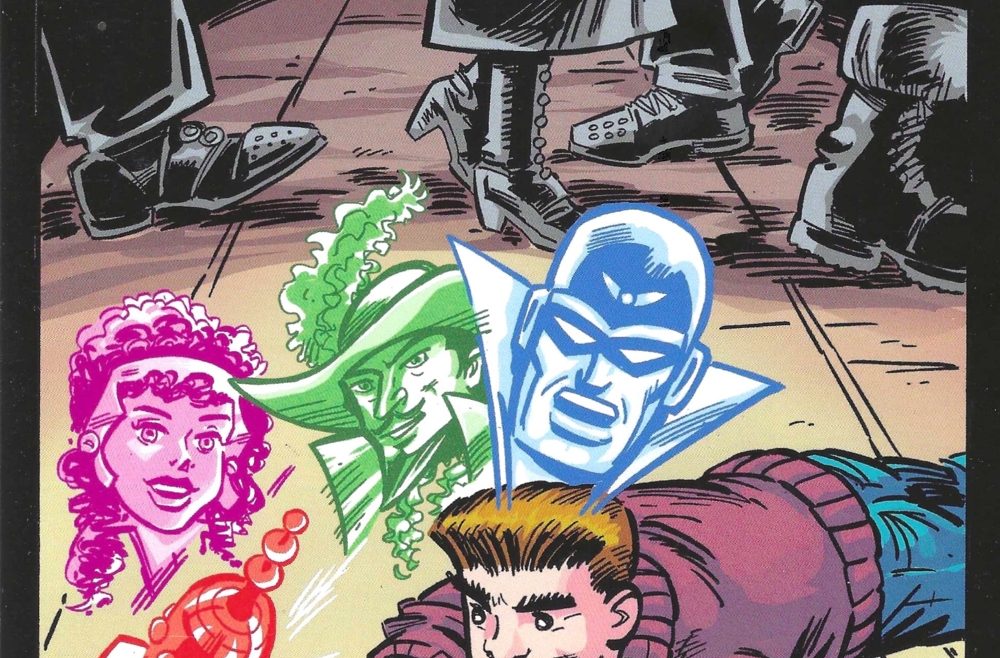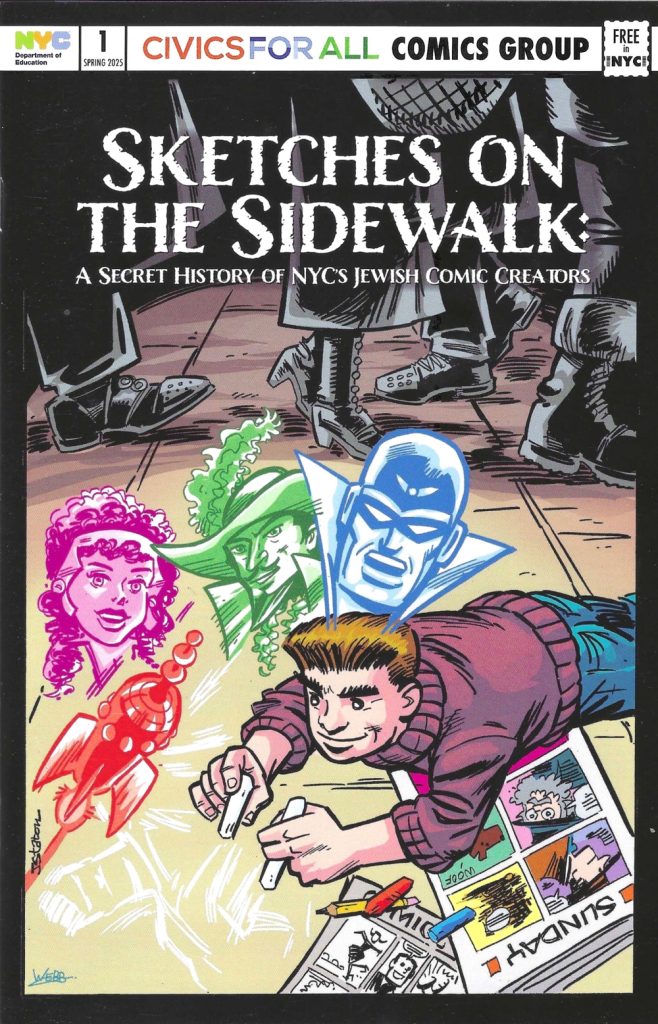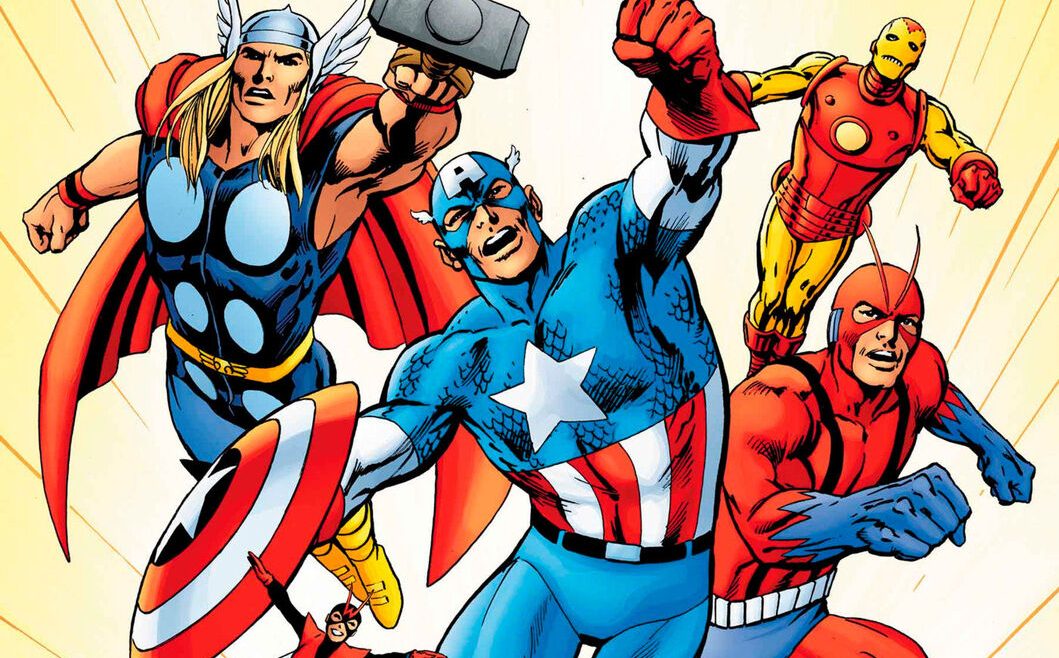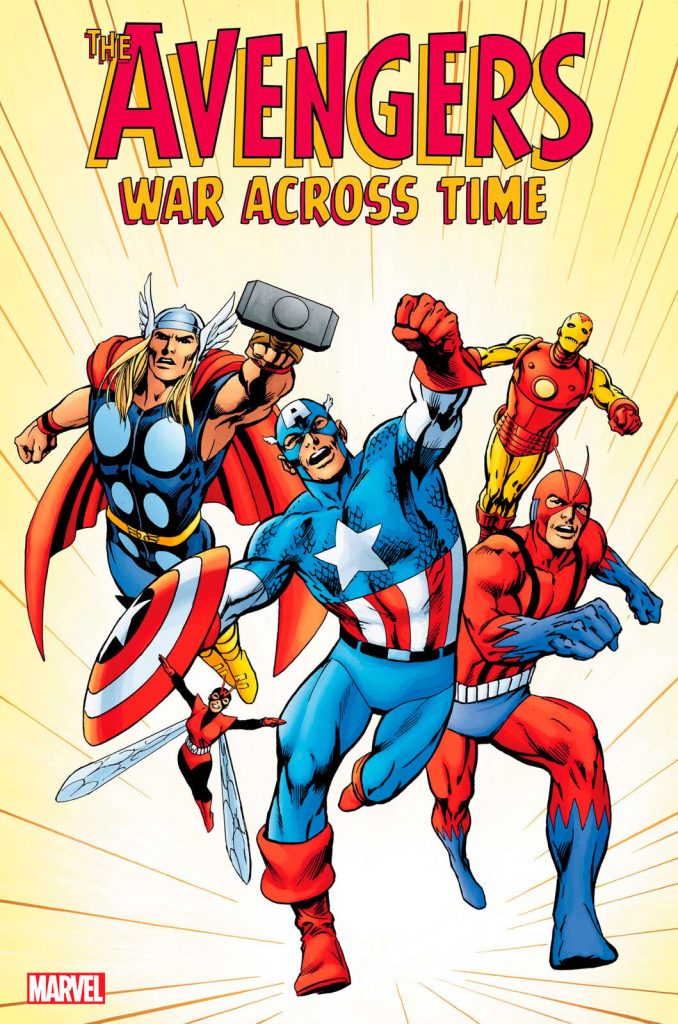It’s a term we used for what have also been called commercial projects and propaganda. There’s a great history of benevolent ones, including the story of Martin Luther King Jr and the Montgomery Bus Boycotts that the Quakers sponsored and which helped inspire John Lewis (MARCH) to join the Civil Rights Movement. As a business guy I’ve been involved in everything from comics to keep kids from being blown up by landmines in the Balkans and Latin America, to drug awareness comics starring the Teen Titans, to some gorgeous mini-comics packed in with Atari video cartridges. The winner in terms of reach was CELEBRATE THE CENTURY, Volume 1, for the US Post Office, trying to entice kids to collect stamps again, but the landmine comics definitely were the best for my soul.
I recently posted about SKETCHES ON THE SIDEWALK: The Secret History of NYC’S Jewish Comic Creators, a new one with Joe Staton. Admittedly to serious comic fans it’s not a secret history, but for most of the comic’s readers I imagine it’ll be surprising. It’s a lovely comic, with appearances by many folks who I knew, and a few who were dear to me. It’s by far the best of these that I’ve done so far, but I’ve dipped my keyboard into the custom world before: working on EDGE OF NIGHT comics for the US Department of Agriculture to encourage better eating habits, or writing mini-comics of Superman and Wonder Woman to go into General Foods cereal boxes (maybe not quite encouraging better eating habits, but tastier ones?). SKETCHES is the first of these I’ve gotten to sign, though.
And I remember the fun of getting these when I was a kid: cowboy stories in new pairs of Wrangler Jeans, our even better, Batman adventures folded up in early Pop-Tarts boxes. Here’s hoping we’re putting smiles on kids’ faces too!
Correcting a transcription error in the newest edition of the JOURNAL OF COMICS & CULTURE reminded me to say a few words about the very nice man who headed DC’s accounting department for at least most of the Silver and Bronze ages of comics. (DC’s financial side was headed by very few people in its history: Jack Leibowitz went from being Harry Donenfeld’s accountant to the head of the company, Bernie Kashdan succeeded him until he became more of a business negotiator and contracts manager, then Arthur Gutowitz (whose name was unfortunately mangled in transcription) took over until I began modernizing the business side of the company in the early 1980s and was able to bring Pat Caldon in to take over.
Arthur was a soft-spoken gentleman, very comfortable with the long-standing members of the company. He kept the processes of accounting running smoothly with a small team, satisfying the corporate supervisors from Warner Publishing and above. I suspect he found the years working with Carmine Infantino as the leader of the company challenging–they were difficult years for the comics industry, our parent company had little knowledge of (or respect for) comics, and the business side of the company wasn’t Carmine’s strong suit. He had a much closer relationship with Sol Harrison during Sol’s presidency, and, I think, was initially wary of my youthful energy and desire for change. He began to respect me more after an incident I won’t relate here, involving some inventory payment irregularities I unearthed by one of the old school, much beloved and respected folks. It wasn’t dishonesty per se, but it wasn’t kosher, either.
When he was shifted to report to me as Sol retired and Jenette became President, it was a little awkward, given the age discrepancy (I was literally the age of his daughter). He was nervous about the pace of change: if we switch to using computers for accounting, what do we do if they break? He was, perhaps, frustrated by the tools I wanted: why do we have to know the profit or loss from individual titles? And he was plainly scared by my goals: why are you budgeting for a profit from the publishing business; if you do that they’ll expect you to do it every year? (Yes, and with one unsurprising exception, we did and steadily increased it, for the thirty years I was responsible for that bottom line.)
I suspect I wasn’t gentle and supportive enough with Arthur during the few years he worked for me; I was in my 20s, and in a rush to make things better. He deserves credit for building and managing the team that made DC a reliable paycheck for talent, a team that continued to be part of his successor’s crew for many years. Sorry about the misspelling, Arthur, and thanks for being patient so long ago.
Driving recently through the wilds of Connecticut saw the sign for Bridgeport, and flashed on 40 Logan Street, an address that in a certain era was a daily part of the life of most comic professionals. Was that what subconsciously led to Wolverine’s name? Who knows, but he was a colorful character…and that was the address of Chemical Color, where virtually every comic book was color separated for many years (not sure if Charlton did their own seps as part of their very vertically integrated operation).
The women who opaqued films to create the screens that were photographed to create the plates were anonymous to the industry, much less to fandom. Seeing the discussion of whether ‘flatters’ who assist in the current color process should be credited along with the colorists who engage them as assistants brings them to mind. Their work was, in a way, analogous to the flatters: covering designated areas with a dark red opaque while reading and interpreting the color guides sent up by the publishing companies. It was a s sort of paint by numbers task, with the main rule being stay inside the lines.
It also brings to mind how linked the comics publishers were in the early 1970s when I arrived. In the morning, Eddie would make the rounds–I apologize for having long forgotten his name, but I can still recall his face and grazed voice clearly. He’d drive down from Bridgeport with the latest proofs: color transparencies for the covers and sometimes first pages, black and white for the interiors; dropping them off in turn at DC, Marvel, Archie and Harvey (not necessarily in that order). Sometimes he’d bring an extra goody–pages from Curt Swan, or another artist who lived fairly near the plant and wanted to save themself a trip to the city. Of course, it had to be an artist who was confident that the editors wouldn’t ask for corrections or adjustments to be made. In the afternoon, Eddie would return, and pick up artwork for issues or covers to be shot, and their color guides. And sometimes, a package back for Curt with a script and a check.
In my time, we had four people still on the staff at DC who had done color seps in the Golden Age of comics: Sol Harrison, who would go on to head production and then become President of the company before retiring; Jack Adler, a true master of color and its technology, who would color DC’s covers for a generation and then follow Sol as the head of production; Midge Bregman, who most of the staff knew as Sol’s assistant or later mine or finally as our office manager or newsstand sales manger, with her separator days a secret identity; and Lois Barker, quietly working in the files that stored the film negatives, either opaquing them for foreign publishers to drop in other language to the speech balloons, or removing the opaque when we wanted to print them in America. Lois might have been the first person of color to work on the DC staff.
There are so many questions I wish I had thought to ask these people. Sol and Jack told a few tales, but only a tiny fragment of the experiences of their lives. The other folks I mentioned just did was needed, day after day, and rarely reminisced or revealed. If only my Time Machine worked, I’d tell myself to be more curious…
Today the announcement was made that Boom Studios! has agreed to a sale to Penguin Random House, a deal I played a small part in as a member of Boom!’s board of directors for the last decade. It’s my hope that this will prove to be a good outcome for most of Boom!’s stakeholders: creative talent, staff, retailers, readers and shareholders. Like any change, it won’t be perfect for everyone, but sometimes there are unintended and unforeseen good outcomes (when I bought WildStorm for DC, we laid off their special projects team as an unhappy part of the transition–but Ted Adams pulled many of them together to form IDW and bring many interesting projects out). My thanks to Ross Richie and Scott Lenet for inviting me onto the Boom! board, and for letting me exercise some of my comics muscles for all these years.
I realized some years ago that my preference for group comics as a young reader had different causes than my pleasure in writing them in my adult years. As writer, it was the ability to have different personalities interact that made them fun…and especially two qualities that the Justice Society and the Legion of Super-heroes shared: they were both in their own little corners of the DC Universe, so I didn’t have to check in with other writers or editors all the time. (Well, occasionally, during the massive cross-over crisis stunts that became more common. But not often.). In addition, both of those series allowed me to affect the lives of the heroes in ways that simply wasn’t available to the writer of JUSTICE LEAGUE.
As a reader, perhaps the different personalities were a factor, though the JUSTICE LEAGUE issues I grew up on kinda failed that test. Gardner Fox plotted amusing sf tales for kids, but it’s generous to assign different personalities to the Leaguers as he wrote them. And my beloved LEGION OF SUPER-HEROES fared a bit better if you look very carefully in Jerry Siegel and Ed Hamilton’s tales, but a lot of the heroes were very similiar in their outlook on life. My view of Saturn Girl or Brainiac Five definitely started from those early tales.
But the next level of my insight into my own psyche as a reader and collector came much later, probably first when I got a chance to write an AVENGERS mini a couple of years ago. I recalled being attracted to a cover of the title where a horde of heroes were depicted. Why hadn’t I gotten into FANTASTIC FOUR when my friend Alan adored the series (and it was genuinely done far better than any of the titles I loved, by my more discerning adult evaluation)? Or sticking within DC, why had I ignored so many of the team titles like DOOM PATROL, CHALLENGERS, SEA DEVILS or RIP HUNTER? (No, it wasn’t the fact that the latter two of those titles were among the most poorly written in the line…I only wish I had that discernment at that age.). Of the ‘second tier’ teams, only METAL MEN caught my interest for a while, though it lost me as Bob Kanigher began to run out of variations on his theme, while TEEN TITANS and BRAVE & BOLD kept me interested.
It was the costumes.
I liked the comics that featured heroes in different costumes working together. Maybe it was the pretty colors attracting me. Or maybe with my poor vision and the hurried artwork of the era (artists producing multiple pages per day weren’t likely to carefully vary facial features and body forms) the varied costumes made it easy for me to figure out who was who. Thinking back, my interest in the X-MEN only happened after they gave up the common blue and yellow uniforms.
Whether my attitude was typical of the 1960s readers or not, it is interesting that the group titles with varied suits charted higher in sales than the single uniform teams, by and large. It was certainly true at DC, though the fact that ADVENTURE COMICS with the Legion then outsold most of the line (and all of Marvels) is more fairly attributed to the power of the Super-symbol on covers, since that level of success was true for the whole Superman family. (Embarassing that JIMMY OLSEN outsold SPIDER-MAN? Sure, but Jack Larson made us care about Jimmy, and Spidey had no such salesman in those years.)
But my latest insight into my reading came this past week, when Joe Illidge guested in one of my courses. Speaking of his own reading habits, he attributed his love of the group books to the fact that he was an only child, and the packs of heroes were found family–the brothers (and occasional sister) he didn’t have. An alarm bell of recognition rang in my head…I’m an only child, too. Maybe that was it?
So it’s early 1973, I’m 16, a high school senior, and lucky enough to have landed the assignment to do DC’s house pages–the equivalent of the Marvel Bullpen pages. They alternate between Direct Currents, the listing of what’s coming in the following week, and Behind The Scenes, a general sort of hype page. I’ve only done one of the latter, when I’m told that for the next one my lead should be about this exciting new title DC is about to launch, something I’m told they expect to be a breakthrough hit. The last couple of launches have been SWORD OF SORCERY and the massive commercial creative and creative success, SWAMP THING, so this should be cool.
It’s confidential enough that I’m sat down at a desk in the production department, camped between the women who do cover and text page paste-ups (if you’re too young to know the term, think desktop publishing with zero tech and lots of rubber cement involved). The boards are brought out gingerly, not having been dumped in the usual production flat files where more mundane things like Joe Kubert’s TARZAN or Kirby’s KAMANDI are stored. This is the comic that’s going to give DC momentum against the burgeoning success of Marvel, coming out against their newer hits like Roy Thomas & Barry Smith’s CONAN or the just-starting TOMB OF DRACULA run by Marv Wolfman & Gene Colan.
I look down.
It’s PREZ #1, by Joe Simon & Jerry Grandinetti. Two solid and talented professionals who have literally been doing successful comics since well before I was born. But in about a page or three I know this certainly isn’t going to be one of them. It’s a tale of a teenager becoming the President of the United States, channelling a bit of the then-recent film WILD IN THE STREETS. But tonally? If Marvel’s capturing the style of the moment, this one is sliding backwards like an awkward Time Machine.
I manage to write a column, and devote more space to the upcoming SANDMAN collaboration between Joe and Jack Kirby…a one shot that would indeed be a hit, if not a project with enough creative bandwidth to sustain a series afterwards for more than a few issues. No memory of what I said to the folks who had waxed enthusiastically about PREZ, but despite the fact that I’ve never been famous for my diplomacy, I must have hidden my confusion. I’d go on to have a long friendship with Joe, and to edit Jerry on some delightful war stories, but I don’t think I ever told either of them about this day.
I could have been wrong. It happened often enough in the decades that followed, and I can’t claim a fraction of the creative success that Joe achieved in a career that included co-creating Captain America and whole romance comics genre. It would have been an interestingly different comic world if I had been, right?
There are quite a number of projects from early in my writing career that I regard as failures: either assignments that I took on and dropped midway for one reason or another (lost KARATE KID when Carmine felt–probably justifiably–that I wasn’t ready to write series yet; abandoned TEEN TITANS faster than Kid Flash could have when LEGION became available), or where I just blew it.
Probably the best of my failures was WONDER WOMAN. Jenette Kahn asked me to take on the series because she felt I wrote female characters well. I hadn’t loved the character growing up. Bob Kanigher’s long run in the 1960s had felt like the weakest of DC super hero titles, and while I had enjoyed Denny O’Neil’s Diana as Diana Rigg issues, that wasn’t really Wonder Woman anyway. I was rooming with Marty Pasko when he wrote his tales, so probably prejudiced in their favor, but all in, not a member of the pantheon I was aching to script.
Thinking through the possibilities, I focused on an elect in her mythos that I did find fascinating: she was the only one of the great heroes who had given up immortality to take on her heroic role. Surely that would be a key that could unlock good stories!
Except I challenge you to find the least homeopathic drop of that idea in the three and a half issues I wrote before running in despair. No fault of editor Ross Andru, an immensely affable man if not the most script-focused of editors I’ve worked with, or of Jose Delbo, who was in the midst of a long run on the character that never failed to be solid and professional, delivering on the potential of whatever (often weak) scripts he was given by me and others.
So all the more I celebrate the wonderful work that George Perez did a few years later, breathing new life into the Amazon Princess and her mythology, and to the many great stories by others that built upon that sensibility.
Sometimes, as Shakespeare said, the fault is not in the stars, but in ourselves. That particular one was one I can’t explain, even to myself, and it’s part of why I gave a sigh of relief this month at the generally warm welcome for my AVENGERS arc. I really wouldn’t have wanted to fail on that one.
This week marked 50 years since I became a comics professional, getting the modest assignment to write Joe Orlando’s letter columns at DC. Looking back over a long and complex run, I’m particularly proud of a few things:
- My role in writing the first standard talent agreement for mainstream comics. After the passage of the 1976 Copyright Act, companies needed to have written agreements with comics talent for the first time. We chose to embody simple but honest terms in DC’s, including things either not guaranteed before (like the return of artwork to artists and reprint fees) or ambiguous (like a specific deadline time within which the assignment needed to be completed, avoiding the occasional situation where someone would come in with work authorized ages before and since reassigned to another person). It was still fairly one-sided, but a great improvement over what had been the practice before, or how some of our competitors chose to deal with the situation.
- Similarly, my participation in getting standard royalties put in place at DC, and as a result, elsewhere in the mainstream. That was very much a team effort, but I found a way to fund it within our budgets that made it an easier sell to management. Top talent like Simon & Kirby had gotten participations back to the dawn of the Golden Age, but making it a basic part of compensation that any successful project could theoretically achieve changed comics, and modernized the mainstream publishers at a critical moment as we moved from a focus on newsstands to comic shops and a more sophisticated audience.
- Less a single dramatic moment, but leading the team that took critical steps to create the graphic novel form in America. Working out a unique business structure to do co-editions of our earliest graphic novels like DARK KNIGHT RETURNS and WATCHMEN, building the strength of graphic novel series like SANDMAN, and ultimately arranging distribution that made these forms more available through changes in how comic shops could order them or bookstores could develop real graphic novel sections was the work of a decade or more, but pioneering in this fulfilled a long-held goal of mine to have comics’ best material consistently available. It seems silly today in a digital, internet-connected world, but it was radical and important in its time.
- Finally, the fact that I got to contribute some elements and stories to the mythos of comics that have endured. It’s a delight to see Helena Wayne back in action again, or see my Lucien become Lucianne, and wonderful to see “the Great Darkness Saga” still pop up on top lists of stories to read.
Thanks to everyone who made this possible, from mentors to readers; it’s been a hell of a journey.




